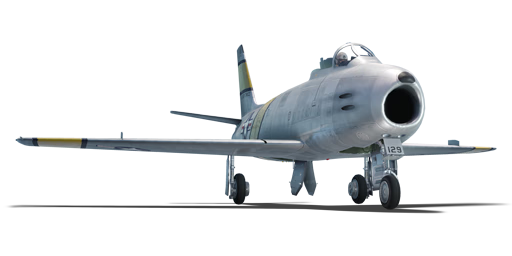



One of the many complaints from pilots flying the machine gun-armed F-86 Sabre was the lack of the hard-hitting punch delivered by cannons. MiG-15s would routinely be hit by machine gun rounds only to shrug it off. Ten F-86s were selected to utilize the T-160 20 mm cannon. They had an impressive fire rate of 1,500 rounds per minute which was both a blessing and a curse. The T-160s had an abysmal amount of trigger time but the high fire rate could also easily take down planes with a tiny burst if aimed properly. Later named Project Gunval, tests continued and no problems were discovered until combat. Eight Gunvals were transferred to Korea and Gunval pilots soon discovered a giant issue. The gas from firing the cannons would be ingested through the air intake and cause engine flameouts. The Gunval Sabres were grounded shortly after until the problem was remedied. The cannon-armed Sabre idea would live on in the F-86H in the form of M39 cannons.
Introduced in Update 1.35, the F-86F-2 is a sleek jet fighter with very potent armament. The four T-160 cannons mounted in the nose are extremely effective against enemy aircraft. Even a short burst will be enough to quickly take down a fighter but comes with a caveat; the high fire rate also means the cannons eat through ammunition extremely quickly. The F-86F-2 has only 115 rounds per gun which is not much since the T-160 cannon has a fire rate of 1,500 rounds per minute.
flaps
flaps
flaps
brake
| Belt | Belt filling | Armor penetration (mm) at a distance: | |||||
|---|---|---|---|---|---|---|---|
| 10 m | 100 m | 500 m | 1000 m | 1500 m | 2000 m | ||
| HEF-I/HEF-I/API-T/AP-I | 42 | 37 | 23 | 13 | 7 | 4 | |
| HEF-I/API-T/AP-I | 42 | 37 | 23 | 13 | 7 | 4 | |
| HEF-I/HEF-I/HEF-I/API-T/AP-I | 42 | 37 | 23 | 13 | 7 | 4 | |
| API-T/AP-I/AP-I | 42 | 37 | 23 | 13 | 7 | 4 | |
| HEF-I/HEF-I/HEF-I/AP-I | 42 | 37 | 23 | 13 | 7 | 4 | |
| Belt | Belt filling | Armor penetration (mm) at a distance: | |||||
|---|---|---|---|---|---|---|---|
| 10 m | 100 m | 500 m | 1000 m | 1500 m | 2000 m | ||
| HEF-I/HEF-I/API-T/AP-I | 42 | 37 | 23 | 13 | 7 | 4 | |
| HEF-I/API-T/AP-I | 42 | 37 | 23 | 13 | 7 | 4 | |
| HEF-I/HEF-I/HEF-I/API-T/AP-I | 42 | 37 | 23 | 13 | 7 | 4 | |
| API-T/AP-I/AP-I | 42 | 37 | 23 | 13 | 7 | 4 | |
| HEF-I/HEF-I/HEF-I/AP-I | 42 | 37 | 23 | 13 | 7 | 4 | |
8 × HVAR rockets












Flight performance | |
|---|---|
Survivability |
|---|
Weaponry | |
|---|---|